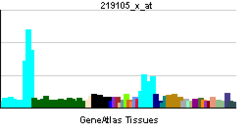- ORC6L
-
Origin recognition complex, subunit 6 Identifiers Symbols ORC6; ORC6 External IDs OMIM: 607213 MGI: 1929285 HomoloGene: 8635 GeneCards: ORC6 Gene Gene Ontology Molecular function • DNA binding
• protein bindingCellular component • origin recognition complex
• nucleus
• nucleoplasm
• nucleoplasm
• nuclear origin of replication recognition complexBiological process • cell cycle checkpoint
• G1/S transition of mitotic cell cycle
• S phase of mitotic cell cycle
• M/G1 transition of mitotic cell cycle
• mitotic cell cycle
• DNA replicationSources: Amigo / QuickGO RNA expression pattern 
More reference expression data Orthologs Species Human Mouse Entrez 23594 56452 Ensembl ENSG00000091651 ENSMUSG00000031697 UniProt Q9Y5N6 Q3TQX1 RefSeq (mRNA) NM_014321.3 NM_019716 RefSeq (protein) NP_055136 NP_062690 Location (UCSC) Chr 16:
46.72 – 46.73 MbChr 8:
87.82 – 87.83 MbPubMed search [1] [2] Origin recognition complex subunit 6 is a protein that in humans is encoded by the ORC6L gene.[1][2]
Contents
Background
The origin recognition complex (ORC) is a highly conserved six subunit protein complex essential for the initiation of the DNA replication in eukaryotic cells. Studies in yeast demonstrated that ORC binds specifically to origins of replication and serves as a platform for the assembly of additional initiation factors such as Cdc6 and Mcm proteins.
Function
The protein encoded by this gene is a subunit of the ORC complex. It has been shown that this protein and ORC1L are loosely associated with the core complex consisting of ORC2L, -3L, -4L and -5L. Gene silencing studies with small interfering RNA demonstrated that this protein plays an essential role in coordinating chromosome replication and segregation with cytokinesis.[2]
Interactions
ORC6L has been shown to interact with MCM5,[3] ORC2L,[3][4] Replication protein A1,[3] ORC4L,[3] DBF4,[3] ORC3L,[3][4] CDC45-related protein,[3] MCM4[3] and Cell division cycle 7-related protein kinase.[3]
References
- ^ Dhar SK, Dutta A (Nov 2000). "Identification and characterization of the human ORC6 homolog". J Biol Chem 275 (45): 34983–8. doi:10.1074/jbc.M006069200. PMID 10945994.
- ^ a b "Entrez Gene: ORC6L origin recognition complex, subunit 6 like (yeast)". http://www.ncbi.nlm.nih.gov/sites/entrez?Db=gene&Cmd=ShowDetailView&TermToSearch=23594.
- ^ a b c d e f g h i Kneissl, Margot; Pütter Vera, Szalay Aladar A, Grummt Friedrich (Mar. 2003). "Interaction and assembly of murine pre-replicative complex proteins in yeast and mouse cells". J. Mol. Biol. (England) 327 (1): 111–28. doi:10.1016/S0022-2836(03)00079-2. ISSN 0022-2836. PMID 12614612.
- ^ a b Vashee, S; Simancek P, Challberg M D, Kelly T J (Jul. 2001). "Assembly of the human origin recognition complex". J. Biol. Chem. (United States) 276 (28): 26666–73. doi:10.1074/jbc.M102493200. ISSN 0021-9258. PMID 11323433.
Further reading
- Li JJ, Herskowitz I (1994). "Isolation of ORC6, a component of the yeast origin recognition complex by a one-hybrid system". Science 262 (5141): 1870–4. doi:10.1126/science.8266075. PMID 8266075.
- Jiang W, McDonald D, Hope TJ, Hunter T (1999). "Mammalian Cdc7-Dbf4 protein kinase complex is essential for initiation of DNA replication". EMBO J. 18 (20): 5703–13. doi:10.1093/emboj/18.20.5703. PMC 1171637. PMID 10523313. http://www.pubmedcentral.nih.gov/articlerender.fcgi?tool=pmcentrez&artid=1171637.
- Hartley JL, Temple GF, Brasch MA (2001). "DNA cloning using in vitro site-specific recombination". Genome Res. 10 (11): 1788–95. doi:10.1101/gr.143000. PMC 310948. PMID 11076863. http://www.pubmedcentral.nih.gov/articlerender.fcgi?tool=pmcentrez&artid=310948.
- Vashee S, Simancek P, Challberg MD, Kelly TJ (2001). "Assembly of the human origin recognition complex". J. Biol. Chem. 276 (28): 26666–73. doi:10.1074/jbc.M102493200. PMID 11323433.
- Chesnokov I, Remus D, Botchan M (2001). "Functional analysis of mutant and wild-type Drosophila origin recognition complex". Proc. Natl. Acad. Sci. U.S.A. 98 (21): 11997–2002. doi:10.1073/pnas.211342798. PMC 59756. PMID 11593009. http://www.pubmedcentral.nih.gov/articlerender.fcgi?tool=pmcentrez&artid=59756.
- Prasanth SG, Prasanth KV, Stillman B (2002). "Orc6 involved in DNA replication, chromosome segregation, and cytokinesis". Science 297 (5583): 1026–31. doi:10.1126/science.1072802. PMID 12169736.
- Strausberg RL, Feingold EA, Grouse LH et al. (2003). "Generation and initial analysis of more than 15,000 full-length human and mouse cDNA sequences". Proc. Natl. Acad. Sci. U.S.A. 99 (26): 16899–903. doi:10.1073/pnas.242603899. PMC 139241. PMID 12477932. http://www.pubmedcentral.nih.gov/articlerender.fcgi?tool=pmcentrez&artid=139241.
- Kneissl M, Pütter V, Szalay AA, Grummt F (2003). "Interaction and assembly of murine pre-replicative complex proteins in yeast and mouse cells". J. Mol. Biol. 327 (1): 111–28. doi:10.1016/S0022-2836(03)00079-2. PMID 12614612.
- Ota T, Suzuki Y, Nishikawa T et al. (2004). "Complete sequencing and characterization of 21,243 full-length human cDNAs". Nat. Genet. 36 (1): 40–5. doi:10.1038/ng1285. PMID 14702039.
- Ramachandran N, Hainsworth E, Bhullar B et al. (2004). "Self-assembling protein microarrays". Science 305 (5680): 86–90. doi:10.1126/science.1097639. PMID 15232106.
- Gerhard DS, Wagner L, Feingold EA et al. (2004). "The status, quality, and expansion of the NIH full-length cDNA project: the Mammalian Gene Collection (MGC)". Genome Res. 14 (10B): 2121–7. doi:10.1101/gr.2596504. PMC 528928. PMID 15489334. http://www.pubmedcentral.nih.gov/articlerender.fcgi?tool=pmcentrez&artid=528928.
- Wiemann S, Arlt D, Huber W et al. (2004). "From ORFeome to biology: a functional genomics pipeline". Genome Res. 14 (10B): 2136–44. doi:10.1101/gr.2576704. PMC 528930. PMID 15489336. http://www.pubmedcentral.nih.gov/articlerender.fcgi?tool=pmcentrez&artid=528930.
- Sibani S, Price GB, Zannis-Hadjopoulos M (2005). "Ku80 binds to human replication origins prior to the assembly of the ORC complex". Biochemistry 44 (21): 7885–96. doi:10.1021/bi047327n. PMID 15910003.
- Mehrle A, Rosenfelder H, Schupp I et al. (2006). "The LIFEdb database in 2006". Nucleic Acids Res. 34 (Database issue): D415–8. doi:10.1093/nar/gkj139. PMC 1347501. PMID 16381901. http://www.pubmedcentral.nih.gov/articlerender.fcgi?tool=pmcentrez&artid=1347501.
- Olsen JV, Blagoev B, Gnad F et al. (2006). "Global, in vivo, and site-specific phosphorylation dynamics in signaling networks". Cell 127 (3): 635–48. doi:10.1016/j.cell.2006.09.026. PMID 17081983.
Categories:- Human proteins
- Chromosome 16 gene stubs
Wikimedia Foundation. 2010.
